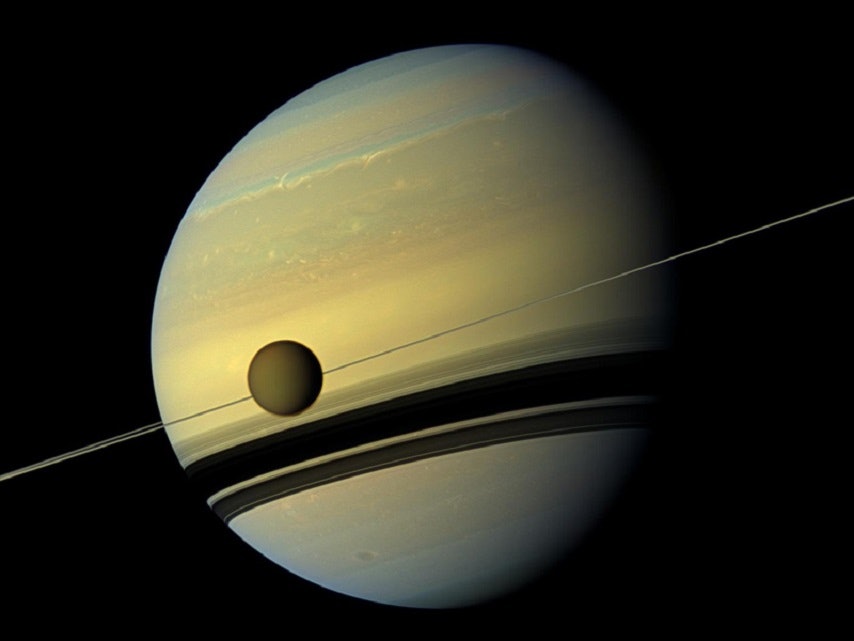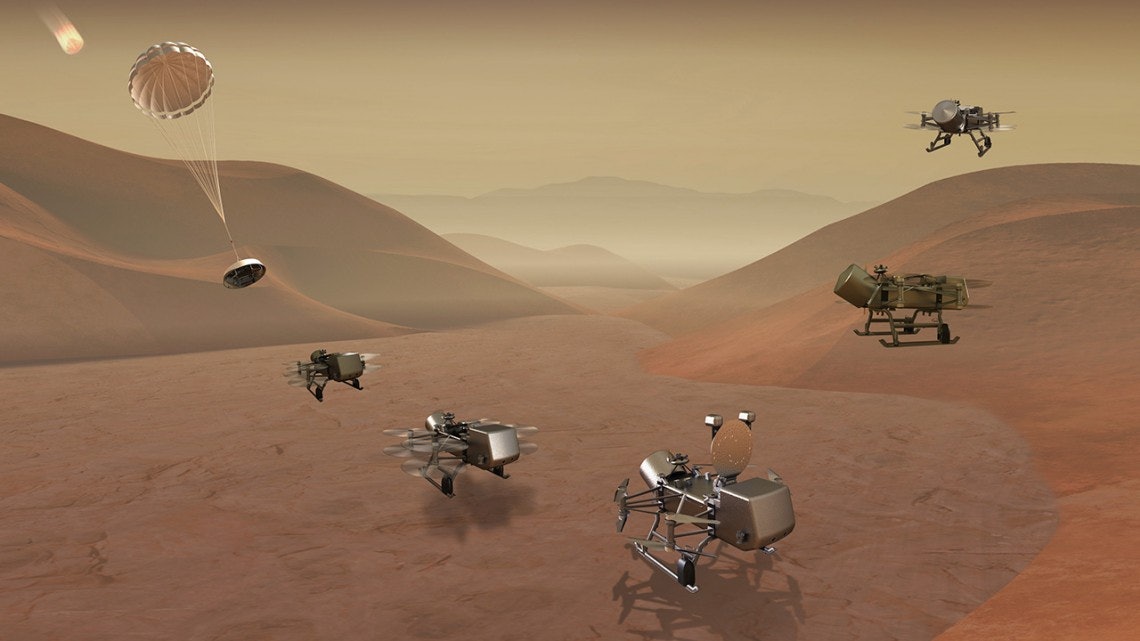
Later this year, the Webb Space Telescope will enable scientists to search for some key building blocks of life in the hazy hydrocarbon atmosphere of Saturn's largest Moon, Titan.
NASA planetary scientist Conor Nixon and his colleagues don't expect to find aliens on Titan, but they may find some clues to how life pulled itself together from similar chemical compounds here on Earth — and how it might do so on other worlds, such as Enceladus or TRAPPIST-1e. And what Nixon and his colleagues find in Webb’s data may help guide NASA’s Dragonfly mission when it sets out for Titan in 2026.
What’s New – Nixon and his team will comb through data from Webb's MIRI instrument for evidence of two ring-shaped molecules called pyridine and pyrimidine: the precursors that form the nucleobases (or "letters") in DNA and RNA. If you add just a couple of extra atoms to pyrimidine, for example, you can make a nucleobase like thymine, cytosine, or uracil. And from there, you've got a good start on building genes and creating life.
Scientists have already found evidence of a very similar ring-shaped molecule called benzene on Titan. Benzene is just a ring of six carbon atoms with six hydrogen atoms on the outside, but Nixon describes it as "kind of the cornerstone of complex organic chemistry."
"If you start looking at amino acids and nuclear bases, they're based around a ring structure," Nixon tells Inverse. "The idea of forming rings is very basic and very foundational to making really lifelike molecules."
That's because ring-shaped structures like benzene are very stable, and they're also very versatile. Think of that basic ring structure as a modular base, onto which chemical reactions can add different attachments to form different organic molecules. Swap out a couple of carbon atoms out for nitrogen, and add some different attachments on the outside, and you've got pyridine and pyrimidine, the chassis on which nucleobases are built. Molecules like pyridine and pyrimidine are sort of an intermediate step between things like benzene and the letters that spell out your genome.
In other words, Nixon and his colleagues want to know whether the building blocks of life — or perhaps just the building blocks for the building blocks — are being assembled by chemical reactions in Titan's atmosphere.
Lab experiments here on Earth have simulated lightning or ultraviolet radiation in Titan's atmosphere, and those experiments show that under the right conditions, energy can kick off chemical reactions that turn simple molecules into more complex ones like pyrimidine.
"So we know that it's possible to happen on Titan," says Nixon, "but what we don't know is does it happen on Titan?"

Nixon and his team are optimistic. During its fateful final orbits in 2017, the Cassini spacecraft skimmed the upper layers of Titan's atmosphere and scooped up a sample for its onboard mass spectrometer, which sorts molecules by mass to tell scientists what something is made of. And Cassini's spectrometer reported molecules in Titan's atmosphere of about the right mass to be the two building blocks Nixon and his colleagues are hunting.
But when Nixon and his team examined Titan's atmosphere with ALMA (the Atacama Large Millimeter Array, a radio telescope in Chile) in 2020, they found no evidence of pyridine or pyrimidine. He says it's possible that the two molecules are there, but not in large enough amounts for ALMA to see.
"But we're going to keep trying," says Nixon. "We think that with more sensitive instruments, such as with Webb, or with longer time durations on ALMA, or making some upgrades to ALMA, we can eventually detect these molecules."
In October, Webb's NIRCam, NIRSpec, and MIRI instruments will measure the infrared spectra of Titan's atmosphere, revealing which chemical compounds are floating around in that orange-ish haze. Because those instruments are more sensitive than Earth-based telescopes or previous space telescopes, and because they're studying wavelengths of infrared light that Cassini didn't cover, there's a chance Webb might see what previous observations missed.
The October observations are part of a wider study of Titan's atmosphere and climate.
"As it's related to the big global picture of Titan, everything is kind of tied together," says Nixon. "Even the weather on the Earth, for example, is related to whether you can sustain life. So some of the other work that we're going to do is going to be really helping to shed light on the bigger picture."
Why It Matters – If Nixon and his colleagues find molecules like pyridine and pyrimidine on Titan, that will tell us that prebiotic chemistry – the kinds of reactions that lead to the building blocks of life – can happen on a world like Titan. And that, in turn, adds to the growing body of evidence that prebiotic chemistry is surprisingly common in all sorts of places in our universe.
That doesn't necessarily mean that life itself is common (or easy to find), but if the ingredients for a living cell are readily available in a wide range of environments – from interstellar dust to the smoggy skies of Titan – the odds might be in astrobiologists' favor. And seeing how those chemical building blocks form and interact in a variety of conditions could help astrobiologists refine their search for life on other worlds.
In the shorter term, though, finding more complex organic molecules on Titan could also help lay the groundwork for NASA's Dragonfly mission, which will send a rotorcraft to search for chemical traces of life, or its building blocks, in 2026.

"The mission is going to have a limited number of places they can visit and a limited number of experiments they can do," says Nixon. "And I think that some of the work that we can do with the astronomy is going to really help them to kind of know what to look for."
What’s Next – When scientists find what they're looking for, it almost always spurs a search for the next thing. In the case of Titan, the next thing is called a functional side group: Different arrangements of atoms that attach to the central ring of a molecule such as pyrimidine, like different tools on a Swiss Army Knife. Those functional side groups are what turn pyrimidine into cytosine or uracil, for example.
Nixon says his team plans to look for those functional groups on other, even simpler molecules.
"That's part of the other job we'll be doing, as well – to look for functionalized molecules that are not ring molecules."
But if Webb's instruments don't reveal evidence of pyridine or pyrimidine, then the search continues. The Dragonfly mission may be the next best hope for finding those and other key chemical ingredients for life.
"I'm really convinced that if we don't find some of these molecules ahead of time in the atmosphere, they're definitely going to find them on the surface," says Nixon, because Dragonfly will be able to dig into the surface itself, where such molecules might be more concentrated. "And I'm pretty confident that they will also even find the nucleobases."
But it's a big jump from nucleobases to DNA, let alone to actual alien life.
"How do you get these molecules to go beyond just being molecules, but to start actually doing things that look like life? Like they're storing information, they're passing on information from generation to generation, they're forming lipid membranes. That's a whole other step," says Nixon.
At the moment, it's also a step we don't fully understand even when it comes to our own Earthling evolutionary origins. Part of the goal of astrobiology, besides figuring out whether there's life on other worlds, is figuring out how life happened here on Earth.







